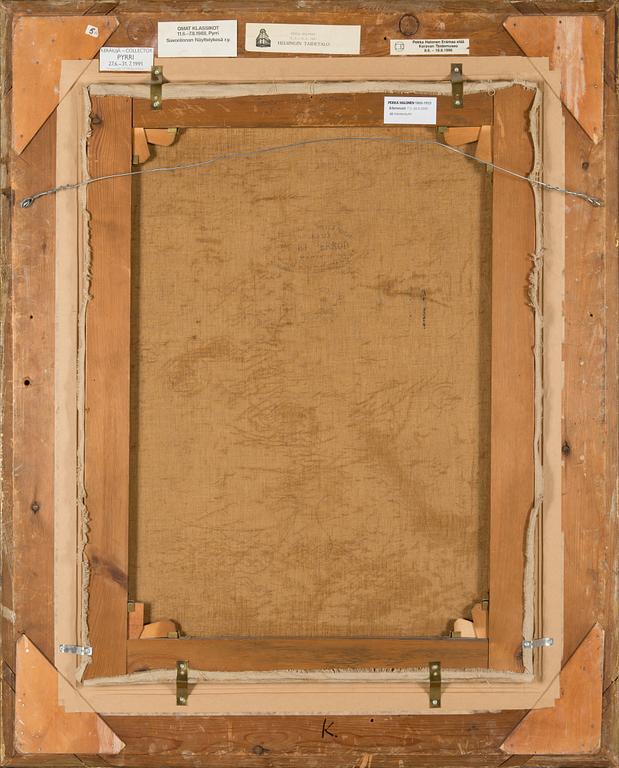Pekka Halonen
Pekka Halonen, "Italian girl".
Sign. Oil on canvas 82x60 cm.
Wear due to age and use.
Provenance
Finnish private collection.
Exhibitions
"Pekka Halonen", Helsinki Taidetalo, 15.3.-10.5.1981
"Pekka Halonen", Retretti Art Centre, Punkaharju, 24.6.-8.8.1982. Illustrated full page in the exhibition catalogue.
"Omat klassikot", Art Center Pyrri, Savonlinna, 11.6.-7.8.1988.
"Keräilijä-Collector", Art Center Pyrri, Savonlinna, 27.6.-31.7.1991.
"Pekka Halonen-130 years since the artist's birth", Lapinlahti Art Museum, 9.6.-27.8.1995, no 13.
"Pekka Halonen Erämää elää", Kerava Art Museum, 8.6.-18.8.1996.
"Pekka Halonen-Four seasons", Retretti Art Center, Punkaharju, 2.6.-28.8.2005.
"Pekka Halonen", Ateneum art museum, Helsinki, 7.3.-24.8.2008, no 42.
Literature
Aune Lindström, "Pekka Halonen-Elämä ja teokset", WSOY, Porvoo, 1957, no 94, illustrated full page on p.68.
Ed. Juha Ilvas, "Pekka Halonen-sanoin ja kuvin", Otava, 1990, illustrated full page on p.35.
"Pekka Halonen-Neljä vuodenaikaa-Four seasons", toim.Ilkka Karttunen, Anna-Maria von Bondsdorff, Retretti Oy Ltd, 2005, illustrated full page on p.110.
"Pekka Halonen", edited by Anna-Maria von Bondsdorff, Ateneum publishings no 52, 2008, illustrated on p.107.
More information
Pekka Halonen is known foremost as a versatile depicter of the Finnish nature, but he also distinguished himself as a painter of excellent portraits. Italian Girl (Italialaistyttö) is one of these brilliant portraits, along with After the Guitar Lesson (Soittotunnin jälkeen) which was painted soon after it. Pekka Halonen had already established himself as an artist after Reapers (Niittomiehet) from 1891, and Minstrel (Kanteleensoittaja) from 1892 exhibited a soulful description of folklife.
Italian Girl was painted in Paris, where Pekka Halonen was studying with a stipend for the third time during 1893–94. Early on, from the value system of his farmer parents, he had assumed the Tolstoian idea of returning to one's roots, respect for the nature and Sermon-on-the-Mount Christianity demonstrated through personal actions. In Paris, together with fellow artist Väinö Blomstedt, he introduced himself to theosophy and esoteric studies, which, accompanied by the teachings and example of Paul Gauguin, led him to seek for the truth outside the sensory world and to show the enigmatic nature of life.
The upright composition of the girl, dressed in a puff-sleeved white blouse and a scarf tied across her chest, represents a new kind of seeing and interpretation. The colour gamut does not follow Gauguin’s Tahitian bright colours, although the reddish green tones of the cross-tied scarf are strong accents for Halonen at this stage. All in all, the colouristic expression in the painting is subtle and mainly corresponds to the sentiments of Camille Corot’s works. The girl’s sitting posture is quite a telling one. Hands peacefully laid in her lap, with her head upright and turned towards the viewer, eyes and mouth expressing introversion. The girl has raised her glance, without looking directly at us. She is in her own inner world unknown to us. In this work, Pekka Halonen has remarkably reached the enigmatic soulfulness of the girl, and that of a human being in general.
Text: Leena Ahtola-Moorhouse
Artist
The artist Pekka Halonen is closely associated with Finnish art, known for his realistic and simple depictions of the Finnish people and nature. Halonen was born in 1865 in Lapinlahti and belonged to a large farming family with several talented artists and musicians as relatives. In 1890, he received a scholarship that enabled him to travel to Paris and study at the Académie Julian. Halonen then continued his studies under Paul Gauguin at the Académie Colarossi in Italy. Like several contemporary Finnish artists, such as Akseli Gallen-Kallela, Halonen eventually returned to his homeland to explore themes in the Finnish wilderness.
Early in his career, Halonen primarily worked in the French Impressionist style, but later his painting evolved into a more monumental approach with subdued colors, often depicting themes from Finnish rural life like 'Road Builders in Karelia' (1900). Colors dominated Halonen's work; he was a virtuoso colorist. The Finnish nature held a central role in Halonen's art, and in his numerous landscape paintings, one can also discern clear influences from symbolism and japonism.
Read more























































